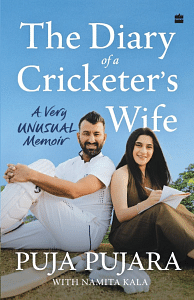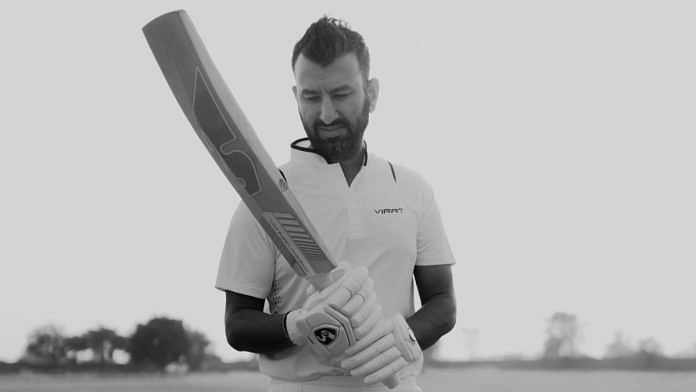On the morning of the last day of the four-match series there was still no clarity which way the match would go or who would take the trophy home. India had to bat the whole day to win or draw the match. That morning, TV broadcasts showed that the cracks on the pitch had widened and the ball would probably drift a lot, a bad omen of how the ball was likely to behave.
The first wicket fell early. Cheteshwar joined Shubman Gill. They built a solid partnership. Shubman had been playing positively right from the start. Cheteshwar was, meanwhile, trying to anchor the innings.
At some point, the opposition felt, Cheteshwar was looking to defend and was not take any chances to score runs. To provoke him into making a mistake, they started bowling bouncers and short balls. When he was batting at six off sixty balls, an Aussie commentator
stated: Pujara looks to be in the zone. The Aussie bowlers should try and rough Pujara up. They should try and rip the helmet off by bowling short stuff!
The things that happened on the field that day were horrifying and the emotions that we as a family underwent cannot be described in words. I was, however, not surprised at this line of thought amongst the Aussies. Cheteshwar, the press had reported at the time, had been the difference between victory and defeat in 2018 and they would do anything to change things this time around.
I knew from the first blow that he took on his body that he was there to stand and fight, no matter what was thrown at him. Such was his body language, his aura that day. He would later state: ‘You can punch me as long as you can. Then I’ll punch back.’
I thought of the 1932–1933 Ashes (Bodyline) series all those years ago that had created such a storm that it had not only threatened the tour itself but also political relations between Australia and the United Kingdom. I took heart from the fact that Bodyline had been outlawed the following year and repeatedly told myself: ‘I hope it will all be worth it at the end of the day.’
In a state of high tension, I invoked god’s name, incessantly asking the almighty to give Cheteshwar the courage to bear the pain. I also prayed and prayed that he would not sustain any major injury, while trying to win the game. He took thirteen visible body blows that day.
Even our two-year-old could sense her father’s pain and our tension. We watched on, cringing at every blow and yet proud at how far he was willing to go to win the match and the series for India.
At 3.20 p.m. Brisbane local time, Cheteshwar was hit so badly on the finger he had injured earlier that he threw his bat. At 4.20 p.m. local time, his logistics manager finally replied to the multiple messages I had sent seeking an update on his injury. ‘He was hit on the same finger at the same place as Melbourne a few days back,’ I was informed.
Later I would discover the extent of the injuries he sustained that day. The first injury occurred just below his shoulder. The second was on the ribs, and he took another blow below the shoulder again, and ‘that’s when the pain became really bad,’ Cheteshwar later told me.
Also read: Kohli is the last superstar of Indian cricket. His impact on the game goes beyond 22 yards
The blows on the helmet were scary but they were not actually that bad. The most painful hit he bore was on his already injured finger when the ball collided with the exact site of his previous injury. Cheteshwar was in so much pain that he could no longer hold the bat with five digits. He took recourse to closing four fingers round it, keeping his index finger away from the handle. But why had he endured so many body blows?
Because he did not want to get caught at leg gully. The Australians had placed a player at leg slip and Cheteshwar was reluctant to take his hands away from his body in case the ball hit his gloves and ballooned over to him.
Shortly after lunch, Hazlewood delivered a ball that did not rise much. It hit Cheteshwar above his left elbow. He walked away from the crease, grimacing. His strategy was the same. He was very confident that as long as the ball was hitting his body, he was fine.
But this particular hit had been more painful than the others, so he called for Nitin Patel, the physio. He needed a break to cope with the pain.
When his index finger took the second blow, Nitin came again. ‘I think I’ve broken my finger,’ he told the physio during the drinks break. ‘You’ll be able to bear the pain. You’ve done it in the past,’ said Nitin encouragingly. ‘Do you want a painkiller for it? Or a strap?’
‘No painkiller,’ said Cheteshwar. ‘It makes me woozy.’ Cheteshwar, by now, had had enough time to figure out how he wished to tackle the injury. He decided to bear the pain. ‘I knew
it was an important time in the game, so there was no way I could back out. Even if it was a fracture, I didn’t want to get bothered about it or think about it. I just wanted to carry on batting,’ he would tell me later.
He had played with a fracture against Australia in the past as well during the home series in 2012-13, in Delhi. In Brisbane, he was not yet sure if it was a fracture or not, and at that stage, he just did not want to know. The second new ball was taken, and Pat Cummins was bowling to Cheteshwar when Bruce Oxenford gave him out LBW. It could have gone either way, but he had raised his finger and Cheteshwar had to depart after a valiant fifty-seven.
I remember shivering and sweating simultaneously. India needed another ninety odd runs with six wickets to win the match or bat twenty overs to push for a draw. Rishabh Pant played an unbelievable innings and India won the match creating history. After the match, when I figured out that Cheteshwar would be back at the hotel, I spoke to him. He was just about to leave for the team celebrations. Aditi, jumping up and down in excitement, innocently assured her father that she would kiss his wounds and chase the pain away. Usually his words, his job when she hurt herself.
 This excerpt from ‘The Dairy of a Cricketer’s Wife: A very Unusual memoir’ has been published with permission from HarperCollins Publishers India.
This excerpt from ‘The Dairy of a Cricketer’s Wife: A very Unusual memoir’ has been published with permission from HarperCollins Publishers India.






